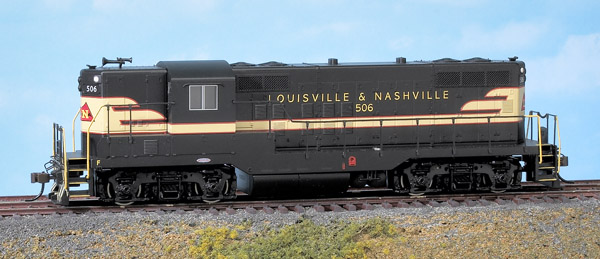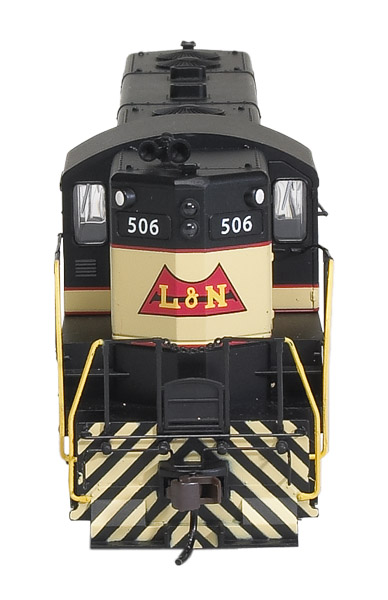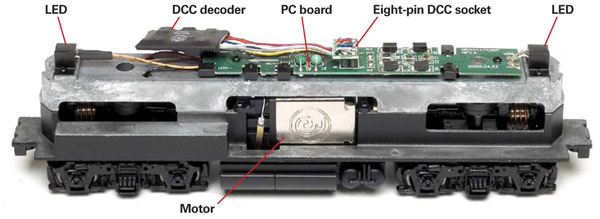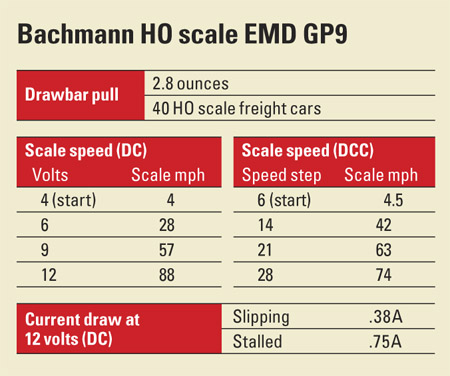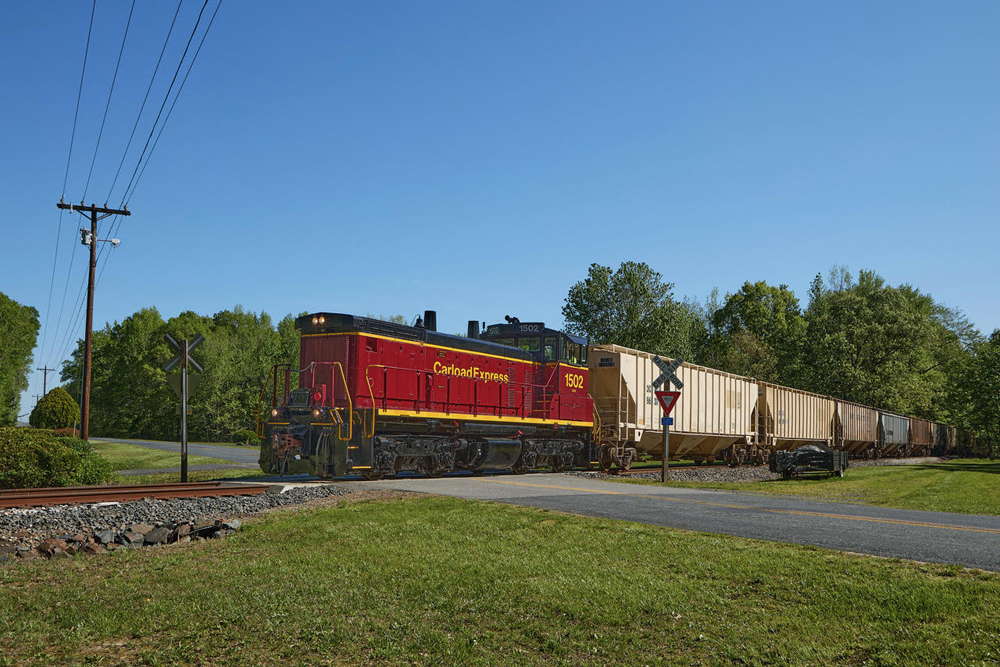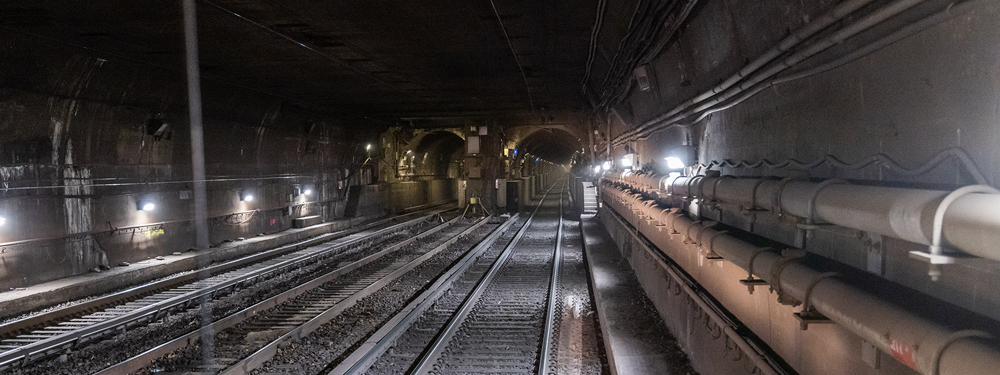Prototype. General Motors Electro-Motive Division built 4,092 GP9 and 165 GP9B diesel-electric locomotives for North American railroads between January 1954 and 1963, when Canadian production ended (GP9 production in the United States ended in 1959). Like its predecessor, GP7, the GP9 was a general-purpose locomotive that handled all sorts of assignments from yard switching and transfer runs to fast freights and passenger trains. Some GP9s remain in service today as switchers, or on short lines and industrial railroads.
The 1,750 hp GP9 has the same basic dimensions as the 1,500 hp GP7. During the GP9 (as well as GP7) production run other external changes took place that railfans and modelers often refer to as “phases.” Early production (Phase I) GP9s are visually identical to the final production (Phase III) GP7s. It’s important to remember that EMD didn’t use the term “phase” and made changes when it saw fit, so there are some overlapping spotting features for various Geep phases.
The model. The Bachmann GP9 matches the dimensions of a drawing in the Model Railroader Cyclopedia, Vol. 2: Diesel Locomotives (Kalmbach Publishing Co., out of print). The Bachmann model is of a Phase II GP9 with four 36″ diameter cooling fans on top of the long hood and louvers on three of the 87” tall engine access doors on each side of the long hood. Phase II GP9 production included locomotives built from 1955 until October 1957.
The handrail stanchions on the model are round, more like the formed metal stanchions found on Phase I GP9s than the pressed metal stanchions typical of most Phase II GP9s. The fuel fill on the model is just to the rear of the locomotive’s midpoint, which is correct for Phase II GP9s until February 1957. At that time, EMD moved the fuel fill forward (toward the short hood).
The handrails and stanchions on the Bachmann model are made of flexible acetal plastic. This material makes the thin parts more durable in case of accidental collisions or mishandling.
Along with the handrails, other separately applied plastic detail parts include the three-chime air horn, sandbox fill hatches, and uncoupling levers. There are also separate valve and pipe detail parts on the two main air reservoirs located behind the fuel tank. The access doors, grills, and louvers are crisply molded on the plastic shell.
Crew figures aren’t included. The cab windows all have clear glazing.
The plastic truck sideframes are painted in satin black. The molded detail matches prototype photos of EMD GP-type trucks. The brake cylinders are separately applied. The faces of the metal wheels are chemically blackened.
Paint and lettering. Our review sample is decorated as Louisville & Nashville second no. 506, which was built in April 1954 as no. 446 and renumbered in 1965. The first no. 506 was a GP7 that also had its number changed in 1965.
According to a prototype photo, L&N GP9 no. 506 had louvers on only two of its 87″ tall engine-access doors on each side. This spotting feature and the built date marks the prototype no. 506 as a Phase I (not a Phase II like the Bachmann model) GP9. All the prototype photos that I found, including one from 1968, show no. 506 in L&N’s gray and yellow paint scheme.
The striping, lettering, and herald placement on the model match prototype photos of GP9s delivered in the 1950s with the L&N’s cream and black freight scheme. The window frames and the edges of the pilot steps are neatly painted. There are even EMD builder’s plates printed on the sills.
Prototype GP9s had inspection slits along the sill that allowed access to the fuel tank. On the model these are printed in gloss black along the sill. It would look more realistic if the model had see-through slits.
The non-functioning class lights are painted white. This color signifies an extra (i.e., non-scheduled) train.
There are two screws that hold the body shell under the fuel tank. You also must remove both coupler boxes before lifting off the shell.
The mechanism is the same as the Bachmann GP7 reviewed in the June 2010 Model Railroader. The motor and flywheels sit in the center of the die-cast metal frame. Two worm gears drive all four axles. A die-cast metal weight covers most of the mechanism.
The printed-circuit (PC) board is attached to the top of the weight. A Bachmann DCC decoder is attached via a wiring harness to an eight-pin socket on the PC board. A jumper board that fits into the socket is also included for those modelers who want to run the GP9 on a DC-only layout.
In DCC, you can program some of the decoder’s configuration variables, including the address (CV1) and the starting voltage (CV2). Using the MRC Prodigy Advance DCC system in our workshop, I programmed the decoder address from the default 03 to the model’s road number. I also programmed CV2 to a value of 15.
Although not listed in the instruction sheet, the decoder supports 128 speed steps as well as 28. The difference between the two settings is most noticeable at low speeds. Using 128 speed steps the model crept smoothly at 1 scale mph in speed step 1.
The decoder has two user-triggered functions in DCC. You can turn the headlight on and off with function 0 and dim the headlight with function 1.
According to our tests with a digital force meter, the Bachmann GP9 can pull the equivalent of 40 HO freight cars on straight and level track. I also ran the locomotive on our Milwaukee, Racine & Troy club layout that uses a CVP EasyDCC system. The GP9 pulled a 26-car freight train up a 1.5 percent grade and pulled a 15-car train up a 3 percent grade without slipping.
Even with its lack of basic details, the Bachmann GP9 is worth a look. The model would also provide a great starting point for a GP9 superdetailing project.
Manufacturer
Bachmann Trains Inc.
1400 E. Erie Ave.
Philadelphia, PA 19124
www.bachmanntrains.com
Era: 1955 to present
Road names: Louisville & Nashville. With dynamic brakes: Atchison, Topeka & Santa Fe; Baltimore & Ohio; Canadian National; Pennsylvania; Union Pacific
Features
- All-wheel drive and electrical pickup
- Dual-mode DCC decoder
- Dual flywheel drive
- Light-emtting diode headlights
- Magnetic knuckle couplers mounted at correct height (front trip pin too low)
- Metal RP-25 contour wheels in gauge
- Weight: 15 ounces





